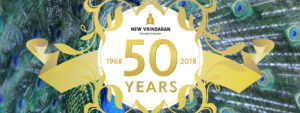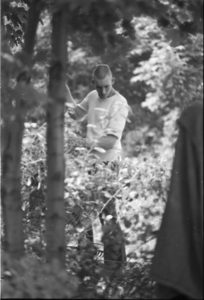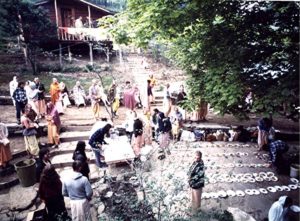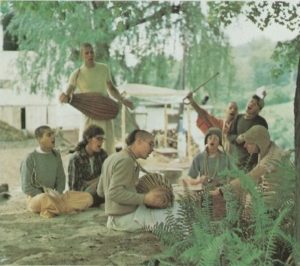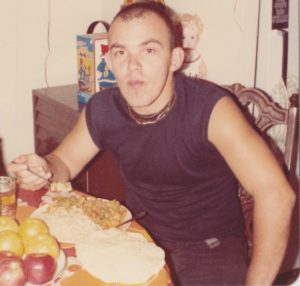NEW VRINDABAN DAYS – CHAPTER 7
NEW VRINDABAN DAYS
As New Vrindaban enters its 50th anniversary (1968 to 2018), I wrote this series of articles for the Brijabasi Spirit in an attempt to give the reader not only an “understanding,” but more importantly a “taste,” of what life in early New Vrindaban was like – through the stories of one devotee’s personal journey.
The title of the series, “New Vrindaban Days,” is in tribute to the wonderful book “Vrindaban Days: Memories of an Indian Holy Town” written by Howard Wheeler, Hayagriva Dasa. He was one of Srila Prabhupada’s first disciples, a co-founder of New Vrindaban, and, a great writer. As with Hayagriva’s book, this series focuses on a period of time in the 1970’s.
I would also like to acknowledge and thank Chaitanya Mangala Dasa, for spending untold hours assisting me in refining my writing for your reading pleasure.
I have been asked to describe certain aspects of early New Vrindaban Community life such as the nature of the austerities, what it was like for a new person coming here, cooking, anecdotes about particular devotees, etc.
I attempt to tell these stories in some semblance of a chronological order, beginning with my first meeting with devotees in 1968, leading to my arrival in New Vrindaban in late 1973 and carrying through to the official opening of Srila Prabhupada’s Palace in 1979.
This article describes my experience of what day to day meals were like during the first year I lived in New Vrindaban.
Advaitacharya Dasa
CHAPTER SEVEN: PRASADAM
Prologue: In January of 1974 I arrive in New Vrindaban thirteen pounds over my street fighting weight of one hundred fifty five pounds. One hundred sixty eight pounds is heavier than I have ever been in my life.
BREAKFAST
The idea of Krishna Consciousness is that a devotee should always think about Krishna, serve Krishna, hear about Krishna, and talk about Krishna, etc. Talking about Krishna is called “Krishna Katha.” In New Vrindaban Krishna Katha has stiff competition with “Prasadam Katha.”
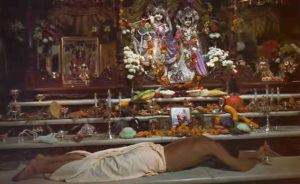
Sumptuous Maha Prasadam being offered to Their Lordships Sri Sri Radha Vrindaban Chandra at Their Bahulaban Temple.
Starting Monday morning the principal subject amongst the devotees are the preparations that were served at the Sunday feast one day earlier. Over the next three days each preparation is discussed in terms of its quality, its quantity, its look, it’s texture, its smell, what it may have reminded you of, when you last had that dish, whether or not is was as good as the last time you had it, etc. These conversations go on until around Thursday when the entire topic of discussion changes. Then, instead of talking about the preparations of the previous Sunday feast conversation quickly swings to discussion of what preparations could possibly be served to Krishna the following Sunday. It is a seemingly endless cycle.
I would like to say that everything in New Vrindaban revolves around Krishna, devotional service, or even Srila Prabhupada’s Palace, but truth be told all of those valuable jewels hang upon the sacred thread of Krishna Prasadam. To understand that one must have a picture of how the devotees are living.
Most devotees rise between 2:30 and 3:00 AM trying to keep up with Kirtanananda Swami who is always in the temple chanting early. Some devotees chant in the temple room and some chant in the Prasadam room where their minds are already transfixed not upon the Holy Name but instead upon Yamini Devi Dasi. It is Yamini who, during the morning program, has the service of dividing up the Maha Prasadam from the day before and putting small portions into steel bowls that are set on the floor in the far corner of the room. The bowls are the individual stainless steel bowls that have been assigned to each devotee and are identified by a red number that is painted on the side. New Vrindaban legend has it that the Swami purchased these bowls at an auction when the local prison closed.
Devotees pace back and forth chanting, hand in bead bag, from one end of the room to the other, where their bowls are being doled out. Instead of a fixed meditation on the sound of Krishna’s name, the more neophyte devotees – like me – are meditating instead upon what Yamini may or may not have put into our bowl.
Meditation upon your morning Maha quota is predicated by the fact that other than the Maha she has given you, the breakfast you will be served is no more than a bowl full of clumpy oatmeal served without anything but hot skimmed milk. I would be criminal if I did not mention that you were allowed more than one bowl if you wanted, but in reality there was really no reason you would want any more than one bowl of this breakfast delight.
Trying to improve breakfast, a few variations are tried over time. The two that stand out in my memory both involve horses. And, unfortunately it is not because I am at the time a horse driver. Thinking along the lines of creating a dry granola, the cooks try a mixture of different grains. Although it may sound like items one might indeed find in granola, those used are of the grade meant to feed the horses. After they have been ground and dry roasted in a wok, a minimal amount of sweetener is added. Regrettably, the sweetener also happens to be cheap corn syrup, normally used for the cows.
Each devotee is served a ladle full of the dry blend and then hot milk is poured over the mix. One might think the milk would be soaked up by the grains and one would have a nice bowl of hot granola. If one were to think that, they would be wrong. Instead of soaking up the milk the grain sits at the bottom of the bowl not absorbing any milk at all. We suffer through this attempt at an improved breakfast for months before we go back to the oatmeal.
Unlike devotees at most temples who dread Ekadasi, we at New Vrindaban welcome it. Although there are no grains or beans served, the New Vrindaban Ekadasi breakfast consists of tapioca. It is a pleasure we look forward to until they no longer allow the tapioca to be sweetened with sugar. This prompts the brahmachari Garga Rsi, who is called on to cook the Ekadasi breakfast, to try sweetening the tapioca one morning by digging into a fifty gallon barrel of horse molasses hidden away in the upper level of the cow barn. The barrel has been in the barn from before the devotees bought this property. Molasses has eaten through parts of the bottom of the barrel and it is slowly making its way out onto the barn floor. Another failure.
Finally, the breakfast dilemma is solved when Bhakta Mark (soon to be Madhava Ghosh), reads an article about chain gangs in the south being able to increase their work output by eating “oat water.” The idea is that the oats are soaked over a period of time and the nutrients seep into the water and is then taken without eating the actual oats. The Swami is intrigued and he assigns one of the community’s best cooks, Sudhanu, to come up with a suitable recipe. Sudhanu’s variation has the oats cooked with a large quantity of water until they are completely dissolved and became more like gravy. The preparation is flavored with a bit of ghee, raisins, salt, pepper, and fresh ginger root. Many of the devotees hate it. I love it. For the next couple of decades oat water is served for breakfast along with white rice.
LUNCH
In the winter, New Vrindaban is a frozen mud puddle. Several times over the years Srila Prabhupada referred to the residents as “inmates.” Trudging through the snow in mud covered winter clothing, smelling like the cows and horses we tend to, one could mistake us for Siberian villagers around the turn of the century. We are weather hardened. We are gaunt. We are willingly, if not begrudgingly, living lives of complete austerity. There is no sense gratification to be had.
I approach the front porch of the temple to find Samba, a devotee who works construction and has become a friend and someone I look up to, sitting in the dark. Taking a seat next to him I ask how he is doing. His response sums up the story of every New Vrindaban inmate.
Samba reflectively mumbles, “I’m freezing when I wake up, I’m freezing when I go to the temple, I’m freezing when I go out to work, I’m freezing when I sit down to eat, and I’m freezing when I come back to my room, and I’m freezing when I go back to bed.”
These descriptions are not the exception – they are the norm. When lunchtime rolls around the devotees file into the Prasadam room and take their places sitting on the floor accompanied by their stainless steel prison bowls and plates. The first server comes around and serves every devotee eleven chapatis. These are not the tender, soft, steaming chapatis lightly smeared with a bit of butter that you may imagine. These chapatis are made of coarsely ground wheat berries donated by the family of Bhakta Mark. They are hard and dry. The only reason anyone could possibly want eleven of these Frisbee like crispy, thin, discs is the fact that the only other thing you will be getting served at this meal is a bowl of “dahl.”
Those familiar with Indian cuisine are aware of the fact that there are many different varieties of dahl beans, all of which are very high in protein. The beans we are eating are not very high in protein. In fact they contain no protein at all because although the dish we are being served is called “dahl” by the devotees, it is in reality no more than a watery broth colored with turmeric with a few pieces of cubed potato and cumin seeds floating in it. We are welcome to have as many bowls as we desire. That is it. No rice. No subji. Chapatis and dahl, make up our entire lunch menu.
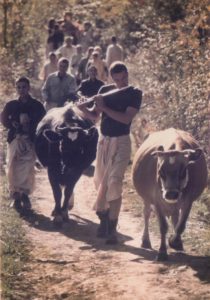
Gargarsi playing his flute and leading a procession on the parikrama path to the original New Vrindaban farmhouse.
On one winter’s day I sit on the cold floor of the Prasadam room pondering my eleven chapatis when Garga Rsi comes walking past me carrying a can of “Bag Balm.” Bag Balm is a salve used to treat skin lesions on the milk bags of cows. Due to poor foot wear, and extreme weather, Garga Rsi has cracks in his feet which rival the ravines of the Grand Canyon. Before I even get the chance to fully digest Garga Rsi’s intention for the bag balm my attention is drawn to the other side of the room.
Mahara Dasi, a vibrant transplant from the New York temple who has recently married Taru das, comes around a corner scurrying guiltily across the Prasadam room. In her arms she clutches a large brown paper bag. Trailing behind her is the pregnant Visvadhika Dasi who also joined in New York City and is married to community poet, Vahna das. Visvadhika is upset and crying after Mahara; “Prabhu. It’s not fair. Why does Taru get so many chapatis? It’s not fair.”
Visvadhika is upset at the fact that Mahara is carrying a bag full of 40 chapatis that have been set aside for New Vrindaban’s “Prasadam Addict” Taru, who happens to have a chapati quota four times greater than any other devotee. To elaborate on the stories that surround Taru could take an entire book. For those wishing to hear some of those stories I recommend looking up “Confessions of a Prasadam Addict,” written by Taru, and which can be found in the Brijabasi Spirit.
The best part of lunch Prasadam is the rousing kirtan right there in the Prasadam room every day before going back to work. We are starving. We are freezing. Our clothes are covered in caked on mud. We smell like cows. Nonetheless the camaraderie and sense of family swells as we chant and dance ecstatically to kirtans led by devotees like Amburish Das, Cirantana Das, Kuladri Das, Garga Rsi Das, and Taru Das.
DINNER
This will not require much of a description. In the evenings the devotees are served salted popcorn without butter and skimmed milk.
PRASADAM ADDICTION
A consequence of this austere diet is that devotees from all walks of community life are often plotting ways to get their hands on Prasadam, by hook or by crook. The night guards spend hours hiding and watching the road for passerby’s that often fire shots at the temple. But, when there are no cars coming they can be found prowling local hiding spots hoping to find stashes of leftover feast Prasadam previously hidden by other devotees.
On one such night Bhakta Mark and myself, while searching a cave for a possible sweet rice stash, are alerted to the fact that a carful of drunks have come right into the center of the patio and have picked up the night guard rifles that they have irresponsibly left on the front porch. We have to sliver down the hill while in the darkness of night to convince the drunken invaders to give back the rifles while the rest of the community sleeps unknowingly.
Each year, on the night of Lord Balarama’s Rasa Lila dance, the community prepares ten gallons of sweet rice, which they carry out into the woods and leave under the moon light for the pleasure of Lord Balarama. This tradition goes by the road side when the devotees that milk the cows sneak out into the forest early in the morning and steal the entire ten gallons.
Some brahmacharis have even been married after they were caught stealing Maha. It seems none of the devotees are immune.
Some devotees are found to have scrape marks on the backs of their hands from where they have tried to slide their hands past nails which have been set up as booby traps to guard the Maha Prasadam.
On one occasion I sit in the Prasadam room chanting with Radhanath Dasa brahmachari, who chants the entire duration of each night sitting on the floor of the Prasadam room in Bahulaban as a form of night guard. While we are chanting we are slowly joined by some of the community’s senior devotees like Kuladri, Taru, Sudhanu, and Garga Rsi. While the entire community sleeps the six of us chant together until in an ecstatic frenzy a few of us stand and begin dancing around Radhanath.
As the chanting and dancing go on ecstatically two of the above mentioned devotees still chanting and dancing make their way to the door of the closet, which is designated as the current Maha cabinet. Without missing a beat I see that they have a system which they have rigged the locked door in a way that they can completely remove it from its hinges. Passing the door off to the side they begin removing tray after tray of Maha Prasadam from the cabinet and in a smiling, laughing, chanting and dancing frenzy we all begin to devour the contents.
For the clarification of his disciples, if I remember correctly, Radhanath Dasa, later to become Radhanath Swami, did not partake…if I remember correctly.
Epilogue: As you may recall, I arrived in New Vrindaban weighing one hundred sixty eight pounds. After my first year I make a trip back to NYC and I weigh one hundred and eighteen pounds.
Did you miss any of the previous chapters? Click the links below to catch up:
Chapter 1: Every Journey Begins With a Single Step
Chapter 2: Srila Prabhupada – Jaya Radha Madhava
Chapter 3: Captured by the Beauty of Sri Sri Radha Vrindaban Chandra
Chapter 4: Fired Up – We Depend On Sri Sri Radha Vrindaban Chandra
Chapter 5: The New Vrindaban Landscape – January 1974
Stay tuned for Chapter 8: Propaganda
